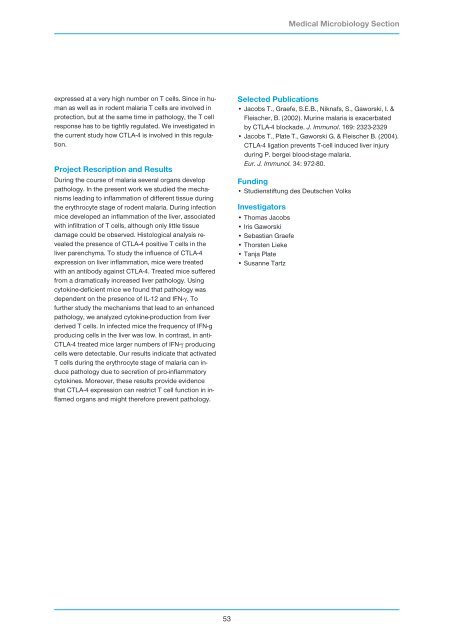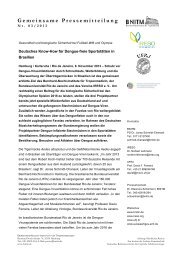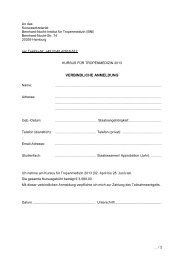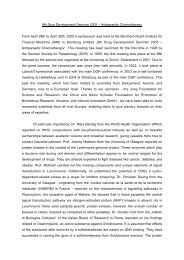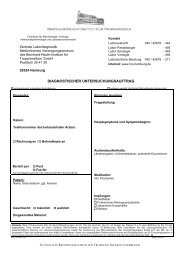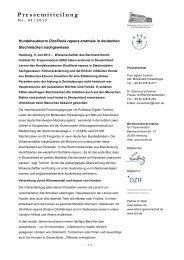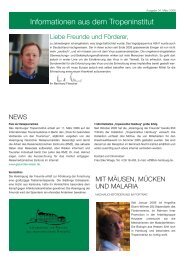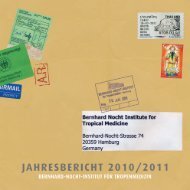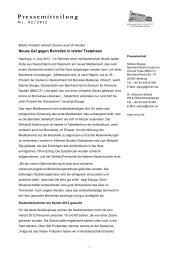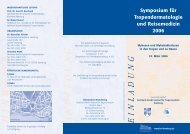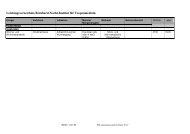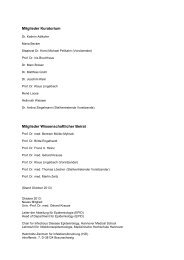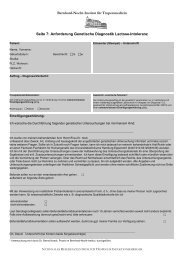Research Group Heussler (Malaria I) - Bernhard-Nocht-Institut für ...
Research Group Heussler (Malaria I) - Bernhard-Nocht-Institut für ...
Research Group Heussler (Malaria I) - Bernhard-Nocht-Institut für ...
Create successful ePaper yourself
Turn your PDF publications into a flip-book with our unique Google optimized e-Paper software.
expressed at a very high number on T cells. Since in human<br />
as well as in rodent malaria T cells are involved in<br />
protection, but at the same time in pathology, the T cell<br />
response has to be tightly regulated. We investigated in<br />
the current study how CTLA-4 is involved in this regulation.<br />
Project Rescription and Results<br />
During the course of malaria several organs develop<br />
pathology. In the present work we studied the mechanisms<br />
leading to inflammation of different tissue during<br />
the erythrocyte stage of rodent malaria. During infection<br />
mice developed an inflammation of the liver, associated<br />
with infiltration of T cells, although only little tissue<br />
damage could be observed. Histological analysis revealed<br />
the presence of CTLA-4 positive T cells in the<br />
liver parenchyma. To study the influence of CTLA-4<br />
expression on liver inflammation, mice were treated<br />
with an antibody against CTLA-4. Treated mice suffered<br />
from a dramatically increased liver pathology. Using<br />
cytokine-deficient mice we found that pathology was<br />
dependent on the presence of IL-12 and IFN-γ. To<br />
further study the mechanisms that lead to an enhanced<br />
pathology, we analyzed cytokine-production from liver<br />
derived T cells. In infected mice the frequency of IFN-g<br />
producing cells in the liver was low. In contrast, in anti-<br />
CTLA-4 treated mice larger numbers of IFN-γ producing<br />
cells were detectable. Our results indicate that activated<br />
T cells during the erythrocyte stage of malaria can induce<br />
pathology due to secretion of pro-inflammatory<br />
cytokines. Moreover, these results provide evidence<br />
that CTLA-4 expression can restrict T cell function in inflamed<br />
organs and might therefore prevent pathology.<br />
53<br />
Selected Publications<br />
• Jacobs T., Graefe, S.E.B., Niknafs, S., Gaworski, I. &<br />
Fleischer, B. (2002). Murine malaria is exacerbated<br />
by CTLA-4 blockade. J. Immunol. 169: 2323-2329<br />
• Jacobs T., Plate T., Gaworski G. & Fleischer B. (2004).<br />
CTLA-4 ligation prevents T-cell induced liver injury<br />
during P. bergei blood-stage malaria.<br />
Eur. J. Immunol. 34: 972-80.<br />
Funding<br />
• Studienstiftung des Deutschen Volks<br />
Investigators<br />
• Thomas Jacobs<br />
• Iris Gaworski<br />
• Sebastian Graefe<br />
• Thorsten Lieke<br />
• Tanja Plate<br />
• Susanne Tartz<br />
Medical Microbiology Section


